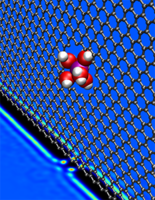当前位置:
X-MOL 学术
›
Rev. Mod. Phys.
›
论文详情
Our official English website, www.x-mol.net, welcomes your
feedback! (Note: you will need to create a separate account there.)
Colloquium: Ionic phenomena in nanoscale pores through 2D materials
Reviews of Modern Physics ( IF 45.9 ) Pub Date : 2019-06-27 , DOI: 10.1103/revmodphys.91.021004 Subin Sahu , Michael Zwolak
Reviews of Modern Physics ( IF 45.9 ) Pub Date : 2019-06-27 , DOI: 10.1103/revmodphys.91.021004 Subin Sahu , Michael Zwolak

|
Ion transport through nanopores permeates through many areas of science and technology, from cell behavior to sensing and separation to catalysis and batteries. Two-dimensional materials, such as graphene, molybdenum disulfide (), and hexagonal boron nitride (hBN), are recent additions to these fields. Low-dimensional materials present new opportunities to develop filtration, sensing, and power technologies, encompassing ion exclusion membranes, DNA sequencing, single molecule detection, osmotic power generation, and beyond. Moreover, the physics of ionic transport through pores and constrictions within these materials is a distinct realm of competing many-particle interactions (e.g., solvation or dehydration, electrostatic blockade, hydrogen bond dynamics) and confinement. This opens up alternative routes to creating biomimetic pores and may even give analogs of quantum phenomena, such as quantized conductance, in the classical domain. These prospects make membranes of 2D materials, i.e., 2D membranes, fascinating. This Colloquium gives a discussion of the physics and applications of ionic transport through nanopores in 2D membranes.
中文翻译:

座谈会:通过2D材料在纳米级孔隙中产生离子现象
穿过纳米孔的离子传输贯穿科学和技术的许多领域,从细胞行为到传感和分离,再到催化和电池。二维材料,例如石墨烯,二硫化钼()和六方氮化硼(hBN)是这些领域的最新成员。低尺寸材料为开发过滤,传感和电源技术提供了新的机会,其中包括离子排斥膜,DNA测序,单分子检测,渗透发电等。此外,离子通过这些材料中的孔和缩颈传输的物理学是竞争多粒子相互作用(例如,溶剂化或脱水,静电阻断,氢键动力学)和限制的独特领域。这打开了创建仿生孔的替代途径,甚至可能在经典领域中提供量子现象的类似物,例如量化的电导。这些前景使2D材料的膜(即2D膜)引人入胜。
更新日期:2019-06-27
中文翻译:

座谈会:通过2D材料在纳米级孔隙中产生离子现象
穿过纳米孔的离子传输贯穿科学和技术的许多领域,从细胞行为到传感和分离,再到催化和电池。二维材料,例如石墨烯,二硫化钼()和六方氮化硼(hBN)是这些领域的最新成员。低尺寸材料为开发过滤,传感和电源技术提供了新的机会,其中包括离子排斥膜,DNA测序,单分子检测,渗透发电等。此外,离子通过这些材料中的孔和缩颈传输的物理学是竞争多粒子相互作用(例如,溶剂化或脱水,静电阻断,氢键动力学)和限制的独特领域。这打开了创建仿生孔的替代途径,甚至可能在经典领域中提供量子现象的类似物,例如量化的电导。这些前景使2D材料的膜(即2D膜)引人入胜。











































 京公网安备 11010802027423号
京公网安备 11010802027423号